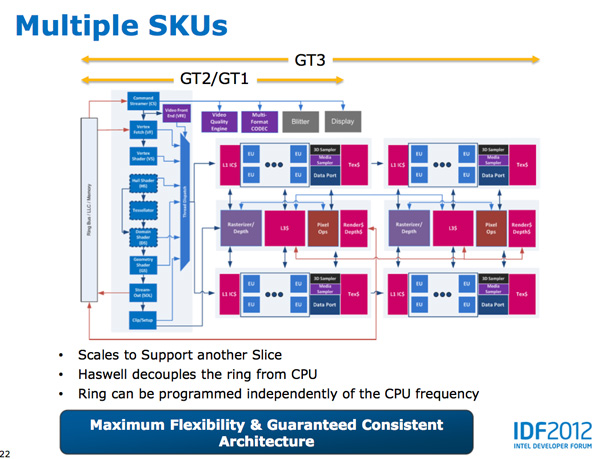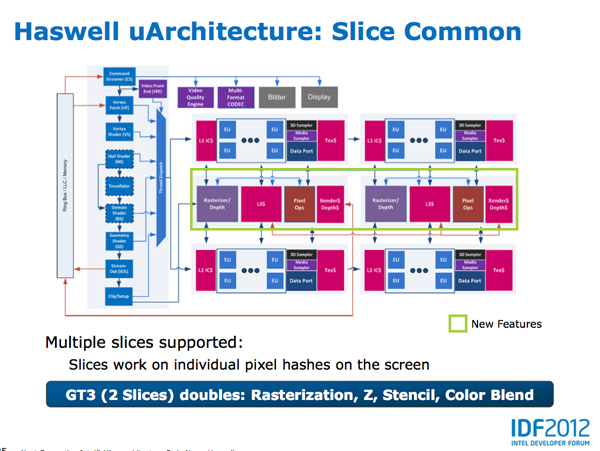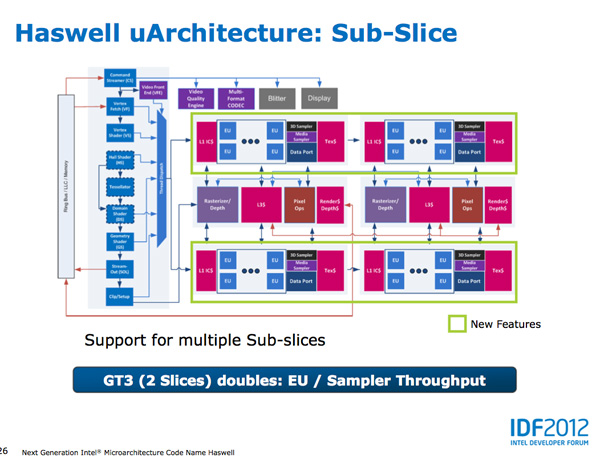Intel's Haswell Architecture Analyzed: Building a New PC and a New Intel
by Anand Lal Shimpi on October 5, 2012 2:45 AM ESTHaswell's GPU
Although Intel provided a good amount of detail on the CPU enhancements to Haswell, the graphics discussion at IDF was fairly limited. That being said, there's still some to talk about here.
Haswell builds on the same fundamental GPU architecture we saw in Ivy Bridge. We won't see a dramatic redesign/re-plumbing of the graphics hardware until Broadwell in 2014 (that one is going to be a big one).
Haswell's GPU will be available in three physical configurations: GT1, GT2 and GT3. Although Intel mentioned that the Haswell GT3 config would have twice the shader count of Haswell GT2, it was careful not to disclose the total number of EUs in any of the versions. Based on the information we have at this point, GT3 should be a 40 EU configuration while GT2 should feature 20 EUs. Intel will also be including up to one redundant EU to deal with the case where there's a defect in an EU in the array. This isn't an uncommon practice, but it does indicate just how much of the die will be dedicated to graphics in Haswell. The larger of an area the GPU covers, the greater the likelihood that you'll see unrecoverable defects in the GPU. Redundancy at the EU level is one way of mitigating that problem.
Haswell's processor graphics extends API support to DirectX 11.1, OpenCL 1.2 and OpenGL 4.0.
At the front of the graphics pipeline is a new resource streamer. The RS offloads some driver work that the CPU would normally handle and moves it to GPU hardware instead. Both AMD and NVIDIA have significant command processors so this doesn't appear to be an Intel advantage although the devil is in the (unshared) details. The point from Intel's perspective is that any amount of processing it can shift away from general purpose CPU hardware and onto the GPU can save power (CPU cores go to sleep while the RS/CS do their job).
Beyond the resource streamer, most of the fixed function graphics hardware sees a doubling of performance in Haswell.
At the shader core level, Intel separates the GPU design into two sections: slice common and sub-slice. Slice common includes the rasterizer, pixel back end and GPU L3 cache. The sub-slice includes all of the EUs, instruction caches and EUs.
In Haswell GT1 and GT2 there's a single slice common, while GT3 sees a doubling of slice common. GT3 similarly has two sub-slices, although once again Intel isn't talking specifics about EU counts or clock speeds between GT1/2/3.
The final bit of detail Intel gave out about Haswell's GPU is the texture sampler sees up to a 4x improvement in throughput over Ivy Bridge in some modes.
Now to the things that Intel didn't let loose at IDF. Although originally an option for Ivy Bridge (but higher ups at Intel killed plans for it) was a GT3 part with some form of embedded DRAM. Rumor has it that Apple was the only customer who really demanded it at the time, and Intel wasn't willing to build a SKU just for Apple.
Haswell will do what Ivy Bridge didn't. You'll see a version of Haswell with up to 128MB of embedded DRAM, with a lot of bandwidth available between it and the core. Both the CPU and GPU will be able to access this embedded DRAM, although there are obvious implications for graphics.
Overall performance gains should be about 2x for GT3 (presumably with eDRAM) over HD 4000 in a high TDP part. In Ultrabooks those gains will be limited to around 30% max given the strict power limits.
As for why Intel isn't talking about embedded DRAM on Haswell, your guess is as good as mine. The likely release timeframe for Haswell is close to June 2013, there's still tons of time between now and then. It looks like Intel still has a desire to remain quiet on some fronts.














245 Comments
View All Comments
tipoo - Sunday, October 7, 2012 - link
I don't think so, doesn't the HD4000 have more bandwidth to work with than AMDs APUs yet offers worse performance? They still had headroom there. I think it's just for TDP, they limit how much power the GPUs can use since the architecture is oriented at mobile.magnimus1 - Friday, October 5, 2012 - link
Would love to hear your take on how Intel's latest and greatest fares against Qualcomm's latest and greatest!cosmotic - Friday, October 5, 2012 - link
Ah, an MPEG2 encoder. Just in time!jamyryals - Friday, October 5, 2012 - link
This made me :)name99 - Friday, October 5, 2012 - link
We laugh but one possibility is that Intel hopes to sell Haswell's inside US broadcast equipment.There isn't much broadcast equipment sold, but the costs are massive, and there's no obvious reason not to replace much of that custom hardware with intel chips.
And much of the existing broadcast hardware (at least the MPEG2-encoding part) is obviously garbage --- the artifacts I see on broadcast TV are bad even for the prime-time networks, and are truly awful for the budget independent operators.
Much like they have written a cell-tower stack to run on i7's to replace the similarly grossly over-priced custom hardware that lives in cell towers, and are currently deploying in China. Anand wrote about this about two weeks ago.
vt1hun - Friday, October 5, 2012 - link
Do you have an idea when Intel will move to DDR4 ? Not with Haswell according to this article.Thank you
tipoo - Friday, October 5, 2012 - link
Haswell EX for servers will support DDR4, but even Broadwell on desktops is only DDR3, we won't see DDR4 in desktops until 2015.jwcalla - Friday, October 5, 2012 - link
We'll probably see DDR4 in the ARM space before we have it on Intel.Maybe this should be AMD's focus of attack: if they can't compete on performance, at least try on chipset features.
Perhaps Intel's biggest concern would be if somebody comes along with a super-efficient x86 emulator for ARM. Going forward, "legacy applications" is going to be an increasingly important selling point to prevent ARM inroads on the low end.
Microsoft keeping their Windows ARM version locked-down is a key to that too, and likely a deference to their relationship with Intel. But Apple is less likely to similarly constrain themselves.
meloz - Saturday, October 6, 2012 - link
>We'll probably see DDR4 in the ARM space before we have it on Intel.>Maybe this should be AMD's focus of attack: if they can't compete on performance, at least try on chipset features.
The problem with DDR4 is likely going to be the price. We all know how the memory industry likes to jack up the prices whenever a new spec comes out. Remember how expensive DDr3 was when it started to replace DDR2?
Some people joke that this transition is the only time they make any money in the RAM business, and considering the low prices of DDR3 you have to wonder.
DDR4 might offer some performance and power advantage on release, but it will likely be more expensive and take time (12-18 months?) to offer a compelling performance / $ advantage over cheap DDR3 variants.
If AMD is trying to position itself as 'value' brand, chaining themselves to DDR4 (before Intel's volume brings down the prices for everyone) could spell their doom.
Kevin G - Friday, October 5, 2012 - link
Intel is set to launch Ivy Bridge EX on a new socket late in 2013 on a new socket. The on-die controller will likely use memory buffering similar to what Nehalem-EX and Westmere-EX use. The buffer chips may initially use DDR3 but this would allow for a trivial migration to DDR4 since the on-die controller doesn't communicate directly with the memory chips.Come to think of it, Intel could migration Nehalem-EX/Westmere-EX to DDR4 with a chipset upgrade. Vendors like HP put the buffer chips and memory slots on a daughter card so only that part would need replacement.